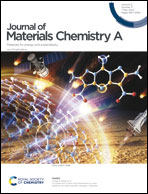Controllable synthesis of an atomic Sn-anchoring carbon host for excellent long-cycle-life zinc metal batteries†
Abstract
Aqueous zinc (Zn) metal batteries are considered to be promising next-generation safe energy storage devices, but the severe hydrogen evolution reaction (HER) and uncontrollable dendrite growth hinder their commercial deployment. In this work, atomic Sn-anchoring carbon spheres with multiple cavities (Sn@HMCS) are developed as an electrode material, to guide/control Zn metal deposition and inhibit the HER and dendrite formation. XANES analysis, DFT simulations and in situ/ex situ characterization of the material reveal that single-atom Sn can enhance the zincophilicity of host materials, lower the nucleation barrier for Zn2+ adsorption, redistribute the charge density of the interface between Zn and the carbon matrix, and accelerate the deposition kinetics of Zn2+, thereby suppressing the formation of dendrites and hydrogen gas during the plating/stripping process. As a result, in Zn–Zn symmetric cells, Sn@HMCS can cycle stably for more than 2300 h at 1 mA cm−2 for 1 mA h cm−2 with an ultralow voltage hysteresis of ≈134 mV. In aqueous full cells, Sn@HMCS endows the devices with high energy density (up to 190 W h kg−1) and stable cycling performance over 900 cycles with a capacity retention of 89% at 1 A g−1.



 Please wait while we load your content...
Please wait while we load your content...